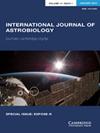Bacterial influence on the formation of hematite: implications for Martian dormant life
IF 1
4区 物理与天体物理
Q3 ASTRONOMY & ASTROPHYSICS
引用次数: 1
Abstract
Previous exploration missions have revealed Mars as a potential candidate for the existence of extraterrestrial life. If life could have existed beneath the Martian subsurface, biosignatures would have been preserved in iron-rich minerals. Prior investigations of terrestrial biosignatures and metabolic processes of geological analogues would be beneficial for identifying past metabolic processes on Mars, particularly morphological and chemical signatures indicative of past life, where biological components could potentially be denatured following continued exposure to extreme conditions. The objective of the research was to find potential implications for Martian subsurface life by characterizing morphological, mineralogical and microbial signatures of hematite deposits, both hematite rock and related soil samples, collected from Highland Complex of Sri Lanka. Rock samples examined through scanning electron microscopy-energy dispersive X-ray (SEM-EDX) spectroscopy. Analysis showed globular and spherical growth layers nucleated by bacteria. EDX results showed a higher iron to oxygen ratio in nuclei colonies compared to growth layers, which indicated a compositional variation due to microbial interaction. X-ray diffraction analysis of the hematite samples revealed variations in chemical composition along the vertical soil profile, with the top surface soil layer being particularly enriched with Fe2O3, suggesting internal dissolution of hematite through weathering. Furthermore, inductively coupled plasma-mass spectrometry analyses carried out on both rock and soil samples showed a possible indication of microbially induced mineral-weathering, particularly release of trapped trace metals in the parent rock. Microbial diversity analysis using 16S rRNA gene sequencing revealed that the rock sample was dominated by Actinobacteria and Proteobacteria, specifically, members of iron-metabolizing bacterial genera, including Mycobacterium, Arthrobacter, Amycolatopsis, Nocardia and Pedomicrobium. These results suggest that morphological and biogeochemical clues derived from studying the role of bacterial activity in hematite weathering and precipitation processes can be implemented as potential comparative tools to interpret similar processes that could have occurred on early Mars.细菌对赤铁矿形成的影响:对火星休眠生命的影响
此前的探测任务已经表明,火星是外星生命存在的潜在候选者。如果火星地下可能存在生命,生物特征应该保存在富含铁的矿物中。先前对陆地生物特征和地质类似物的代谢过程的调查将有助于确定火星上过去的代谢过程,特别是指示过去生命的形态和化学特征,在那里,生物成分在持续暴露于极端条件后可能会变性。该研究的目的是通过表征从斯里兰卡高地复合体收集的赤铁矿岩石和相关土壤样品的形态学、矿物学和微生物特征,发现火星地下生命的潜在影响。岩石样品通过扫描电子显微镜-能量色散x射线(SEM-EDX)光谱检查。分析显示球形和球形生长层由细菌成核。EDX结果显示,与生长层相比,核菌落的铁氧比更高,这表明微生物相互作用导致了组成的变化。赤铁矿样品的x射线衍射分析显示,赤铁矿的化学成分在垂直剖面上存在差异,土壤表层最上层富含Fe2O3,表明赤铁矿在风化作用下发生了内部溶解。此外,对岩石和土壤样品进行的电感耦合等离子体质谱分析显示了微生物诱导的矿物风化的可能迹象,特别是母质岩石中被捕获的微量金属的释放。利用16S rRNA基因测序对岩石样品进行微生物多样性分析,发现岩石样品以放线菌属和变形菌属为主,主要为铁代谢细菌属,包括分枝杆菌属(Mycobacterium)、Arthrobacter、Amycolatopsis、Nocardia和Pedomicrobium。这些结果表明,从研究赤铁矿风化和降水过程中细菌活动的作用中获得的形态和生物地球化学线索可以作为潜在的比较工具来解释早期火星上可能发生的类似过程。
本文章由计算机程序翻译,如有差异,请以英文原文为准。
求助全文
约1分钟内获得全文
求助全文
来源期刊

International Journal of Astrobiology
地学天文-地球科学综合
CiteScore
3.70
自引率
11.80%
发文量
45
审稿时长
>12 weeks
期刊介绍:
International Journal of Astrobiology is the peer-reviewed forum for practitioners in this exciting interdisciplinary field. Coverage includes cosmic prebiotic chemistry, planetary evolution, the search for planetary systems and habitable zones, extremophile biology and experimental simulation of extraterrestrial environments, Mars as an abode of life, life detection in our solar system and beyond, the search for extraterrestrial intelligence, the history of the science of astrobiology, as well as societal and educational aspects of astrobiology. Occasionally an issue of the journal is devoted to the keynote plenary research papers from an international meeting. A notable feature of the journal is the global distribution of its authors.
 求助内容:
求助内容: 应助结果提醒方式:
应助结果提醒方式:


